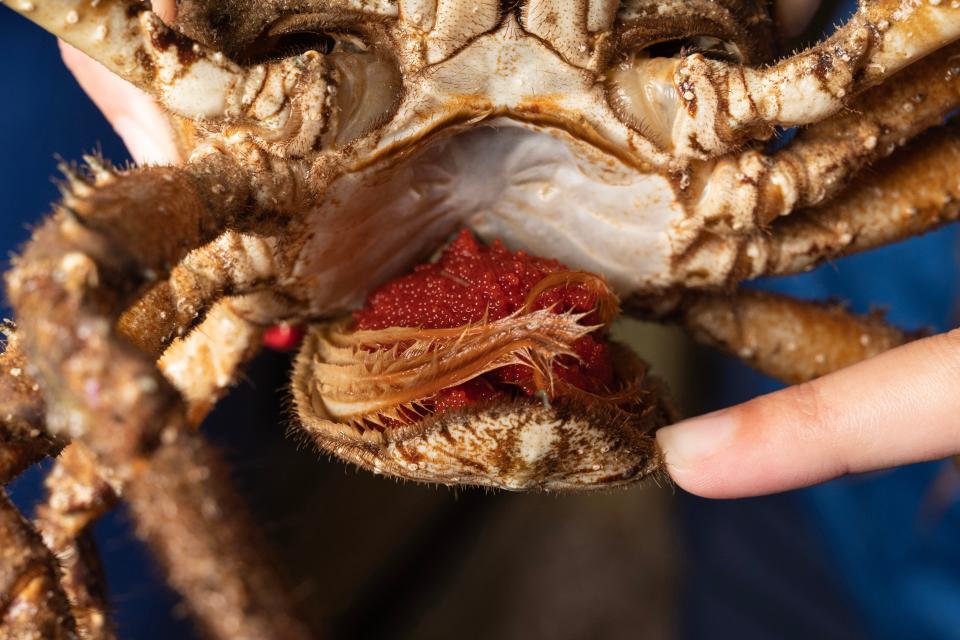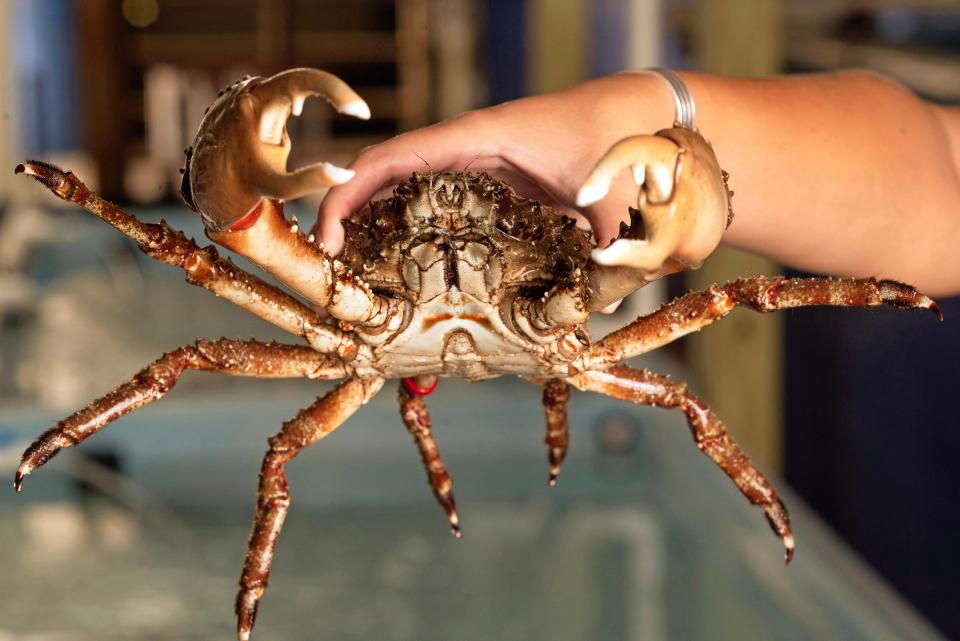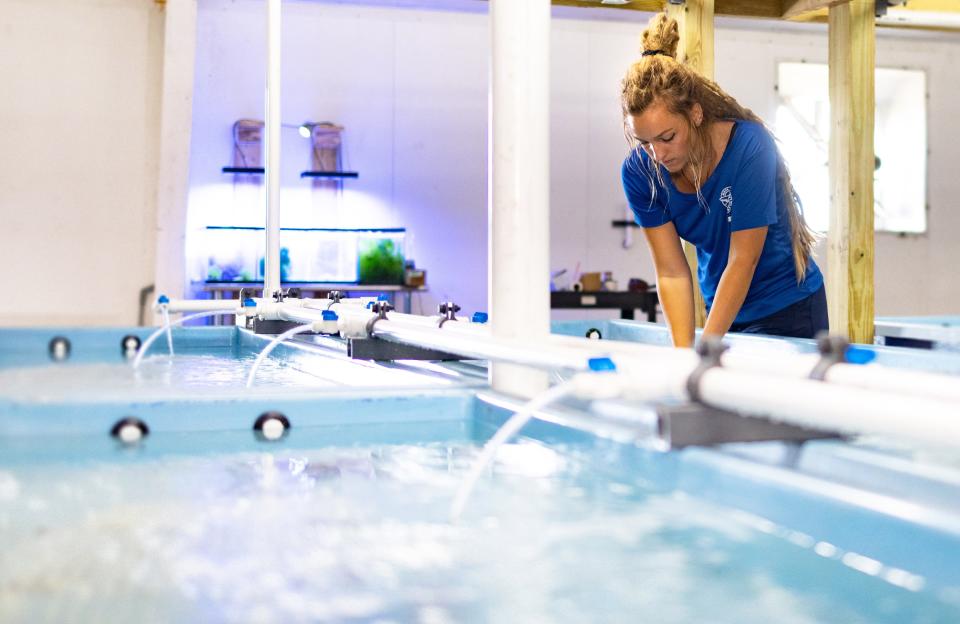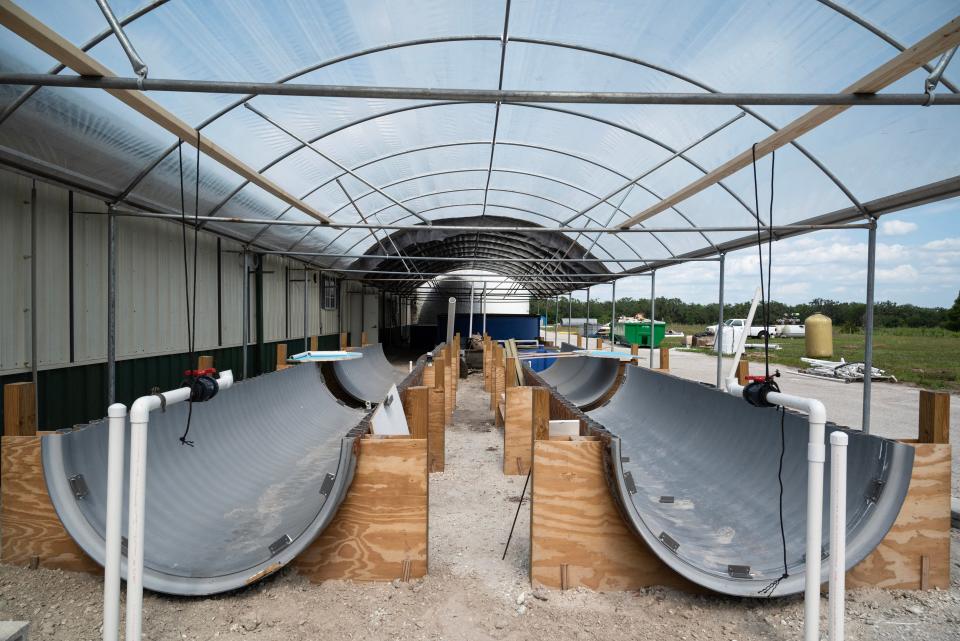Caribbean king crabs arrive at Mote Aquaculture Park; seen as key to restoring coral reefs
The first baby Caribbean king crabs born at Mote Aquaculture Research Park arrived Tuesday morning – less than a week after their mom and 31 other crabs moved north from the Elizabeth Moore International Center for Coral Reef Research and Restoration on Summerland Key in South Florida.
The thousands of siblings are resting comfortably in their nursery while their mother has already been moved back into a tank with other adults.

The baby crabs will play an integral part in the $100 million effort to restore coral along the Florida Reef Tract – even if they never make the trip back to Summerland Key to dine on algae at one of seven iconic reef sites targeted for restoration – because they will be test pilots for the buildout of the Mission Iconic Reefs regional grazer hatchery.
Related: Mote receives nearly $7 million from NOAA to enhance Keys coral reef restoration effort
Once fully operational, the hatchery will produce upwards from 250,000 Caribbean king crabs a year. Those crabs will be placed back on the reef with the hope that they will eat enough algae to make the environment more hospitable to the genetically resilient coral planted on the reefs.
“They’re definitely a big part of the restoration strategy for Florida’s coral reef,” Mote Coral Reef Restoration Research Program Manager Jason Spadaro said. “The crabs and Diadema – the long-spined sea urchin – together, as complementary grazers that actually facilitate the success of more direct restoration initiatives, like planting corals on the reef.”
Mission Iconic Reefs, unveiled in December 2019 by the National Oceanic and Atmospheric Administration, is an ambitious plan to restore as much as 3 million square feet of coral on seven important reefs.

Initially the plan has been focused on a goal of improving coral coverage on the seven reefs from 2% to 25%. In April Mote Marine Laboratory & Aquarium received a $7 million grant that signaled the next phase – the planned introduction of Caribbean king crabs as part of a holistic approach toward reef restoration.
Over the next four years, scientists will plant 242,000 coral fragments and add 34,000 Caribbean king crabs on 10 reef sites – the seven targeted by NOAA and three others by Mote.
Moving day
The May 10 arrival of about a dozen adult females, a half dozen adult males and another dozen or so juvenile crabs marks the ramping up of the facility at the 200-acre Mote Aquaculture Park off of Fruitville Road east of Interstate 75, as well as a shift in purpose for the labs on Summerland Key.
Earlier: Crabs that may help save Florida's iconic reefs will be born and bred on land
“Down there we’re going to focus on the research and the ecology side of it,” Spadaro said. “This is the aquaculture side of it.”
For now, adult crabs are kept in long, rectangular fiberglass tanks, or raceways, as workers put the finishing touches on two large 20,000 gallon tanks repurposed from when the building housed a sturgeon production facility. The tanks will be used as ecosystems for the crab hatchery.
The broodstock tank will contain between 300 and 400 adult crabs, including 15 and 20 males, though as they get large, they also become territorial and tend to fight.

Scooter is the largest crab to make the trip from Summerland Key to Mote.
Mote Content Development Manager Hayley Rutger named the crab Scooter as a nod to Spadaro’s current mode of transportation, a four-wheel knee scooter he has been using while recovering from a fractured heel bone spur.
Time will tell if Scooter will become as endearing an icon around Mote Aquaculture Park as Big Red, the one-clawed Caribbean king crab, became around Summerland Key.
Big Red died in February. Spadaro said a cause could be determined and it may have been old age, since much of the life cycle of the species is being documented as part of the project.
“We don’t have Big Red anymore but we have probably hundreds of thousands of his babies,” Spadaro said.
Since starting the king crab project, scientists have documented that it can take 10 to 18 months for a crab to become an adult, Spadaro said, but they need to see others die in captivity to establish a lifespan.
A place to grow
The second 20,000-gallon tank will house juvenile crabs until they get to the size of a quarter – after which they would be shipped off to the Keys to populate the reef.
Both tanks will contain rocky features for the crabs to climb and explore.
A third 20,000 gallon tank will contain clean water as part of the overall circulatory system.
An outdoor aquaponic system will eventually contain algae. Water, rich with nutrients produced by the crabs, will feed the algae.

The algae will clean the water, which will circulate back to the indoor tanks.
Algae from the aquaponic tanks also double as a major food source for the crabs.
The goal, Spadaro said, is to have the larger tanks ready for crabs to move in by June 1.
Tom Waldrop, senior biologist and production manager for the grazers at Mote Aquaculture Research Park, and staff biologist Cierra Bair will dive in the tanks to make sure they're running smoothly, as well as check the adult females to see if they need to be transferred to the maternity ward tanks.

Eggs of a pregnant female crab at first appear bright red.
“It’s the first stage of development,” Bair said as she showed off a clutch of eggs from a pregnant female. “It’s bright red and then a dark red or a wine color and then a tan … it takes a couple of weeks and at the very end it turns translucent and then see-through and you know they’re coming.”
The whole process could take as little as a month.
Once hatched, they remain in that tank while they are free floating.
Then they’re moved to another tank or raceway until they grow to the size of a dime then eventually on to the larger tank.
Once the permitting process has been completed, those juveniles will be placed out on the reef.
Once the larvae hatch, Spadaro said they will be at several thousand animals very quickly.
Each female can have between 2,000 to 200,000 eggs in one clutch, depending on it size, with the average clutch near 60,000 eggs, Spadaro said
The crabs in captivity have no exposure to predators. Scientists are figuring out a protocol to ensure they’re not easy prey when placed out on the reef. Exposure to puppets and actual predators are part of that plan – likely at the Summerland Key facility until a protocol is established.

Meanwhile Waldrop and Bair will run little risk while diving in the big tanks among the herbivores.
King crab claws don’t pose too much of a risk said Spadaro, who studied the species while earning his doctorate.
“It’s not the claws that get you, it's these wicked dactyls on the legs,” Spadaro said, while pointing to one of Scooter's back legs. “They’re channel clinging crabs … you can put him on top of one of these rocks and he’ll grab it and you can lift him up and the rock will come with him.
“But when you’re holding him and they get those legs around, they start grabbing onto your arm, you’ll end up with these scratches all around your arm.”
This article originally appeared on Sarasota Herald-Tribune: Caribbean king crabs move to Mote Aquaculture Park

